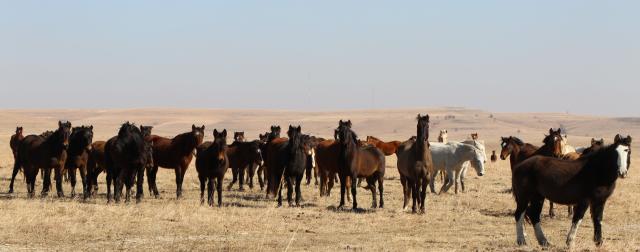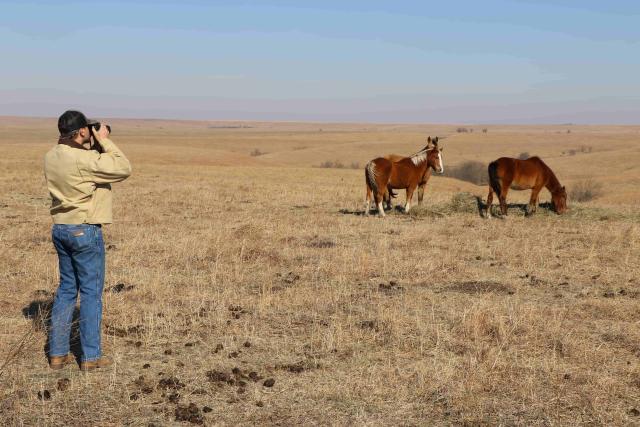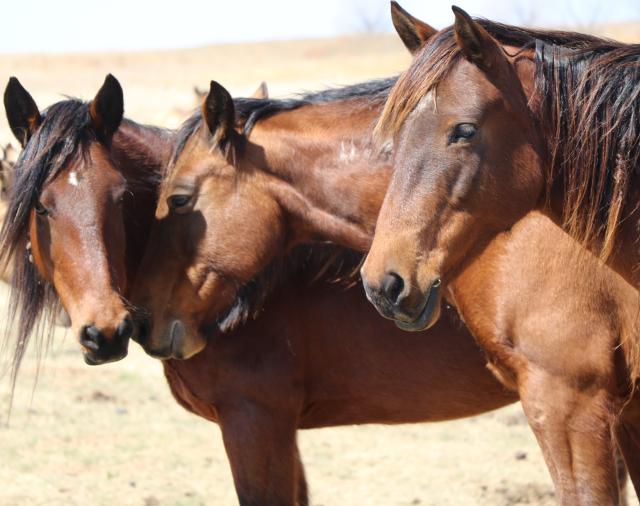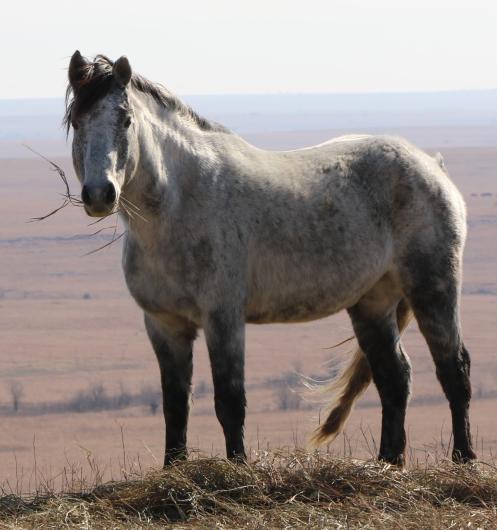You are viewing ARCHIVED content published online before January 20, 2025. Please note that this content is NOT UPDATED, and links may not work. Additionally, any previously issued diversity, equity, inclusion or gender-related guidance on this webpage should be considered rescinded. For current information, visit https://www.blm.gov/blog.
Living in Nirvana
By Special Contributor Paula Cook
We recently had the opportunity to visit a few off-range pastures where some of the wild horses gathered from our rangelands are cared for by private landowners under contract to the Bureau of Land Management (BLM). There are currently a total of 38 off-range pastures and four public off-range pastures in operation, including sites in Missouri, Montana, South Dakota, Utah, Washington and Wyoming, in addition to the pastures overseen by our host for this trip, Preston Rushing, who is in charge of monitoring pastures in Oklahoma, Kansas, Nebraska and Iowa. The current total population of these pastures is just over 39,000 wild horses, and their care is overseen by three Project Inspectors in addition to Rushing. Each Project Inspector travels to the pastures under their supervision four times a year, recording and reporting on the condition of the horses cared for there.
We tagged along for some of Rushing’s quarterly pasture inspections, excited to see first-hand where many of these icons of the West were living out their lives. Our first visit was to a 7,000-acre ranch south of Oklahoma City where approximately 1,150 wild horses are currently cared for.

We started our tour at the working pens used to receive the horses when they arrive at the pasture, usually in truckloads of 32 or 33 head per shipment. The affable facility owners, fourth generation Oklahoma ranchers who fed cattle on the ranch prior to contracting to care for wild horse herds, showed us how the loading chute and fencing had been modified to accommodate horses from their previous use as cattle pens. “Mostly we had to raise the height of the chute’s overhead support, as horses are not only taller but also carry their heads higher than cattle,” said our host. “We don’t want them bumping their heads as they walk out of the truck. Our fencing also had to be raised to six feet in height, and we had to add about thirty miles of fence around the perimeter of our ranch to meet the stringent requirements in place to protect the horses.”
When the horses are initially received they are unloaded into a specific enclosure with extra tall and highly visible fencing to allow them to become accustomed to their new surroundings. “We call this the acclimation pen,” said the rancher. Here the horses are carefully evaluated as they adjust to the plush grass that will be the primary fodder in their new home. Horses also become accustomed to come to the siren of the feed wagon in this pen. During winter months the horses are fed with a truck which rolls out huge round bales of hay and dispenses high protein feed pellets as it drives through the pasture.
We continued our visit by driving through acres thick with golden grass, green shoots of new growth just beginning to show through the thatch. We were in a pasture with a couple hundred mares of varying ages who trotted toward our vehicle curiously and stopped near the truck, heads held high and gazes alert as we exited carrying our cameras.
Project Inspector Rushing took pictures of the horses with his camera as well as making notes on body scores and range conditions on the paperwork he pulled from his folder. He discussed the feeding program for the mares with the rancher, who explained that this particular pasture had enough new growth to keep the horses at a healthy weight, so their supplementary feeding had been stopped for the summer a week or so prior to our visit. He went on to explain that though the pastures the ranch owns are all in a close geographic area and had nearly identical types of forage, the groups of horses were evaluated on an individual basis. Some groups, primarily those with a higher percentage of older individuals requiring more feed to stay at an optimum weight, were still being supplemented by the feed wagon and would be until the spring grass was plentiful enough to maintain them at a healthy weight.

As a lifelong horsewoman, I noticed one thing about the pasture of mares that truly puzzled me. The horses we observed all had nearly perfectly smooth, round, symmetrical feet. I did not see one set of hooves that was overgrown or cracked, which invariably happens to any domestic horse living in a pasture environment if their feet are not maintained with regular farrier visits.
“Do you trim their feet?” I asked. The question got a chuckle from my companions. “Nope, they do it themselves!” was the reply. The ranch owner went on to explain. “We have lava rock around here in various parts of the pasture. The horses will stand beside a rock and stomp and stomp a foot. Pretty soon you will see little pieces of the hoof flying off, and before long the horse will change to another foot. When they leave you can go over near the rocks and see hoof fragments laying all around.” This was news so incredible that it took a moment to absorb.
“Can we see some of the hoof trimmings?” was my natural next question. Our host readily acquiesced but noted we may or may not find any to view. “The ground squirrels and voles come and pick them up and eat them pretty quick,” he said. ‘Wild hogs like them too; the keratin in the hoof helps keep their coat, teeth and body healthy.”
“Wait….what? Wild hogs?” I exclaimed! “Yes,” was the laughing reply. “There are huge dens of wild pigs who live here in the trees and brush. As surprising as it seems, they cohabitate with the horses very amiably. You can see a line of them walking right through a grazing herd and the horses will not even lift their heads.”
We drove through the pasture into an adjoining acreage and traveled through a dense thicket of trees lining a meandering stream bed. As we moved we passed several large ponds, naturally filled by the 32 to 35 inches of rain the area gets each year. The water supplies are situated about every 300 yards; a stark contrast, it struck me, to the many miles these horses may have traveled to water in their original herd areas.
The outcropping of lava rocks we saw next was visually striking but proved a disappointment in the search for hoof trimmings. “They get cleaned up pretty quickly once the horses leave them,” said the ranch owner. Having watched my dogs in their frenzy of ground search for hoof fragments after a farrier visit I was not surprised to hear that.
We moved on to more pastures owned by our host, each filled with healthy and happy horses that ambled over to see what we were doing. At each stop Rushing took photographs and made notes cataloging the condition of the horses and the range that supported them.
Our next pasture visit took us to neighboring Kansas to visit one of the largest and longest-term ranches contracted to care for wild horses. At 33,000 acres in total, the sheer size of the ranch was hard to fathom. The vast landscape is home to approximately 2,300 head of wild horses, some of which have been in the facility since near the inception of their contract with BLM as a long-term holding pasture in the early 2000’s.
The breadth of the landscape made us wonder if we would get close enough to view any horses, but our fears were unfounded. The horses living in this facility were still being fed hay, as the grass was just starting to grow the green stalks heralding the promise of knee-tall pasturage to come. We watched as a feed truck arrived, driving through the swinging gate and along a faint track in the mostly dormant foliage. A line of horses in the distance trotted toward us, and when the truck got close to where the hay would be unrolled the driver turned on a siren announcing that breakfast was served. The sight of the hundreds of horses, in every color a horse could be, lining the path of lush hay being distributed by the feed wagon was nothing short of breathtaking.
Once the hay was all fed we had a chance to visit with the driver of the truck, who was one of the ranch managers that helped oversee the operation. It was obvious that this individual loved the land, revered the horses, and took great pride in the ranch’s long partnership with the BLM in providing these animals quality care through the end of their natural lives.
We were surprised to learn that even with the thousands of horses cared for by the three-member ranch team, individual animals were noted and observed, with particular vigilance bestowed upon any that may be falling behind in body condition or losing interest in eating. When an animal can no longer move around the pasture to reach feed or water, or is imminently near that condition, it must be humanely euthanized, a job that nobody enjoys but which is an essential part of managing the animals with integrity and respect.
The feed truck driver told us of a recent horse that had passed away, and when the brand on its neck was examined to document the loss they were astonished to learn that the horse was 40 years old. He surmised that the animal must have been one of the earliest arrivals at the ranch and that it had lived a long and healthy life for twenty or more years after it arrived at the pasture.
It was fascinating to observe the interaction of the horses in this vast physical space. The animals were contained in pastures hundreds of acres in size and separated by sex to prevent reproduction. This particular ranch maintained a ratio of roughly one horse to seven acres of land, and what was intriguing was that even with all the available space the horses still formed naturally into groups, some units with just a few head of horses and some with what seemed like dozens.
The interaction between group members was typical of what you see in domestic herds of horses or wild horses in their native habitat; there is always a leader who chooses the feeding spot and need only display a pin of an ear or swing of their hindquarters to warn others away, and below the absolute authority of the lead horse is a clear hierarchy of dominance, with the most docile members of the group waiting patiently for their herd mates to settle in before choosing their own spot to enjoy the plentiful fodder. Settling into these family-type units is a clear representation of the natural instincts of horses as herd animals, and a testament to their innate adaptability when changes to their environment occur.

We concluded our visit to the ranch with visits to some of the other pastures contained in its expanse. Rushing followed his now-familiar protocol in each pasture, documenting the condition of the horses and the pasture where they grazed with written annotations and photographs, which he explained would be reviewed by his supervisor upon his return to the office.
Our trip ended with a few hours of windshield time as we drove back to the Norman office. I reviewed my notes and some of the photographs that we took, reflecting on the impressive system that has been created to provide these untamed animals the capacity to live out their lives with a social structure similar to where they originated, only with an ease of physical existence far greater in the bountiful grasslands than it would have been in the often barren and overpopulated regions from where they were gathered.
As a native Idahoan who loves to trail ride, I have explored the BLM land near my home on horseback many times, and more than once have seen the stunning sight of a wild horse herd standing on a faraway ridge or galloping in the distance. Looking around the beautiful ranches these herds now called home was stirring. In the native habitat where wild horses live near us the predominant foliage is sagebrush. There are generally few trees for shelter and water sources can be miles apart. The horses that have been relocated to off-range pastures were truly living in nirvana, with thick grass, plentiful water, and readily available natural shelter in abundance.
These horses are fortunate to have the protections that enable them to live their lives in comfort and ease, an existence that would not be possible without the dedication of the ranchers who house them and the careful oversight of the many BLM employees like Preston Rushing and the other Project Inspectors who oversee their care.

Related Content
Related Stories
- Progress on Public Lands: BLM 2025 Trump Administration Accomplishments | January 20 - December 31, 2025
- Popular posts: BLM's most viewed blogs of 2025
- “Where did my horse come from?” BLM launches a new way for adopters, trainers and others to learn about their wild horses and burros
- Lake Havasu Fisheries Improvement Program is the gift that keeps giving
- BLM is thankful for public lands volunteers
